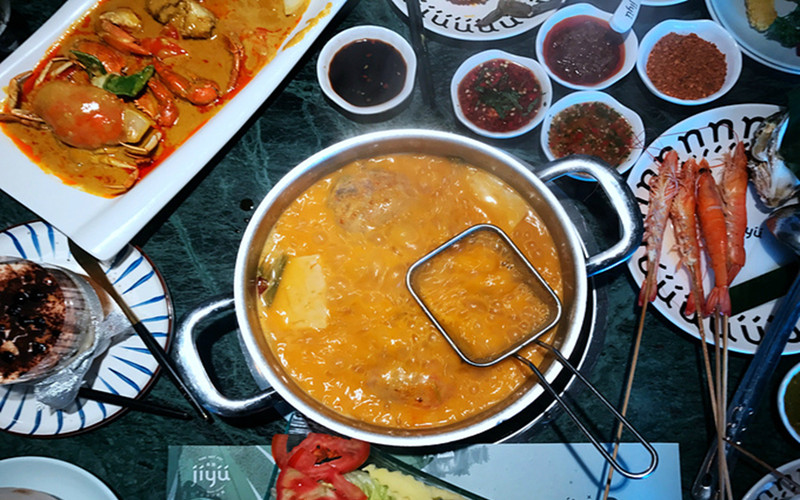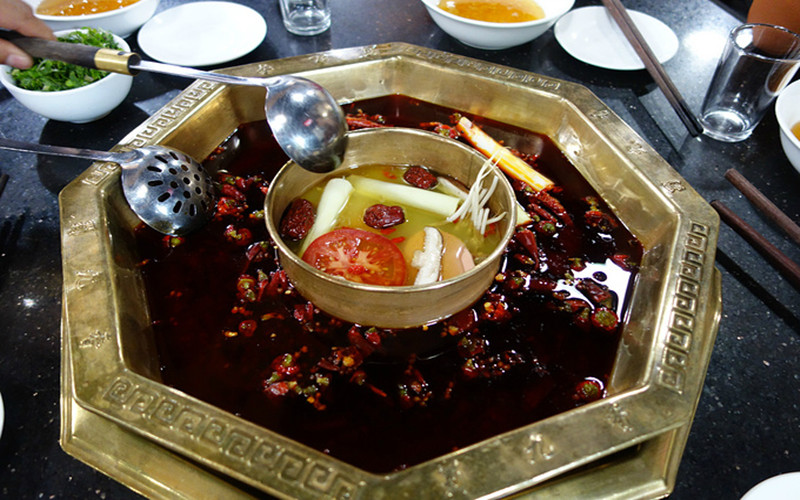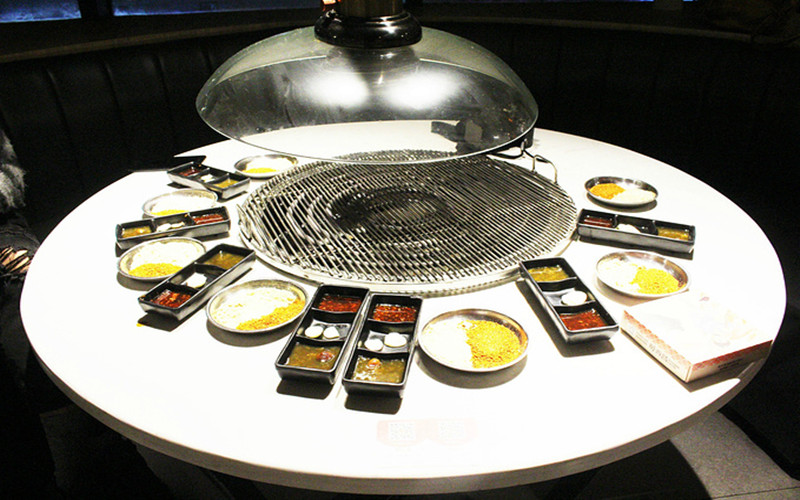Sichuan hotpot,one of dishes of Sichuan Cuisine, is famous for its hemp, spicy, fresh and fragrant flavor. It comes from the folk and is sublimated in the temple.

Whether it is a peddler, a dignitary, a scholar, a merchant, a farmer, or a man/woman, it has a wide range of consumer groups and a large number of per capita consumption. As a kind of food, hotpot has become a representative food in Sichuan and Chongqing.
History of Sichuan Hotpot
Sichuan hotpot came into being in the Daoguang period (1821-1851) of the Qing Dynasty. Through multiple textual research, the real birthplace of Sichuan hotpot is Xiaomi Beach (now Gaoba No. 25 Factory), a wine city on the bank of the Yangtze River. The cooker is only a tile jar with water (soup) in it, various vegetables, and pepper and pepper to dispel dampness (because there is a saying that "food is divided into three parts, and pepper is used as clothing").

At that time, the boatmen on the Yangtze River often stayed overnight at Xiaomitan (which was a very suitable dock on the Yangtze River in Sichuan at that time). They would start a fire and cook to keep warm after stopping the boat. After the boatmen ate, the beauty was indescribable (in their hearts), and it spread from one place to another, spreading to hundreds of people at various docks along the Yangtze River.

At that time, Chongqing was a major waterway transportation hub, much larger than Luzhou.
This kind of food custom has been inherited and passed down to Chongqing, and then underwent another transformation.
At that time, some coolies ("sticks") saw this way of eating and went to the cattle slaughterhouse to pick up some discarded cow organs and wash them in the Yangtze River. They cut them into small pieces and ate them with the boatmen.

Everyone thinks it's very delicious, it can fill their stomachs and drive away the cold.
Later on, some people simply used one or two baskets, with one end containing some beef offal (mainly tripe) and small dishes, and the other end containing a clay stove. They placed a partitioned "ocean iron pot" on the stove, boiling and rolling a spicy, salty, and fragrant brine inside the pot. They would sell it every day by the river, bridge, or on the streets and alleys.
So these boatmen and coolies (sticks) no longer started their own fires to cook. Each person decided to cook one dish and eat it immediately until they were full, without spending much money. It was both economical, convenient, and able to increase calories.
In addition to those laborers, there are also more and more people coming to gather and carry the burden to eat.
It wasn't until the 23rd year of the Republic of China that someone moved it into a small restaurant and placed these handles on the table. The clay stove remained the same, but the divided iron pots were replaced with small red copper pots. The braised and dipping sauces were prepared by the diners themselves to ensure cleanliness and suitability for everyone's taste. Gradually, more and more small restaurants of this kind opened, and almost all of them were on a small street in Jiangbei, across the river from Chongqing, with a considerable number of people eating it. This is the origin of "Chongqing tripe hotpot".
Later, in order to remember that this way of eating was passed down from Xiaomitan, people simply called this street "Xiaomi Street".
Even later, during the Anti Japanese War, Sichuan hotpot became increasingly prosperous. Officials, financial giants, businessmen, journalists, etc. were proud of eating hotpot, and some people also nobled this hotpot restaurant.
Many Kuomintang veterans who fled to Taiwan before the founding of the People's Republic of China still cannot forget the deliciousness of Chongqing hotpot, and some have even opened hotpot restaurants in Taiwan (but due to raw material issues, they often cannot catch up with the local Sichuan flavor).
So many books say that Sichuan hotpot originated in Jiangbei, Chongqing, but in fact it originated in Luzhou and developed in Chongqing.
Features of Sichuan Hotpot
Under the action of firepower, the soup and braised dishes in hot pot are in a boiling state, and the diners eat while scalding, combining heat and taste. In addition, the preparation of soup and braised dishes is very particular, containing various glutamic acids and nucleic acids that interact with each other in the soup and braised dishes, producing a very tempting fresh aroma. In addition, high-quality seasonings are used, and fresh dishes and dishes are truly fresh and flavorful, with endless aftertaste.
Taste Popularization: Diversified varieties and flavors have been implemented to meet the needs of different diners. In addition, the blending of dozens of different flavor dishes makes it more adaptable and suitable for popular tastes.
More widely used materials: from the traditional "beef offal" of Maodu hotpot to the increase of raw materials such as birds, animals, mountain delicacies and seafood today, there are countless varieties of Sichuan hotpot; in a word, all food that can be eaten can be boiled or scalded in hotpot.
Exquisite production: In addition to selecting high-quality seasonings, the cooking of soup ingredients, processing of raw materials, preparation of flavor dishes, placement of dishes, and the art of steaming are all very particular and reasonable
Willingness and Convenience: The joy of eating hotpot lies in the enjoyment. Friends, family, guests, and companions gather around the hotpot, cooking, boiling, eating, and chatting at the same time. It can be rich or frugal, and the joy is endless, just as the Qing Dynasty poet Yan Chen wrote, "Gathering around the stove, drinking, and cheering, all kinds of flavors dissolve into a small pot.
Nourishing and strengthening the body: Due to the use of ingredients, it is very beneficial to the body. If you sweat profusely after eating, it has a certain therapeutic effect on treating colds and can dispel rheumatism, especially foods with high nutritional content. It also has a certain effect on health and strengthening the body, as well as assisting in the treatment of certain diseases.
Eating Tips
1. Eating hotpot is mostly done by boiling meat, which is often infected with Toxoplasma gondii. The infection rate of Toxoplasma gondii in sheep is about 60%, pigs is about 20%, and cows is 14%. Toxoplasma gondii often hides in the muscles of these infected animals, and short-term heating of hotpot cannot eliminate it. Pregnant women may experience miscarriage, stillbirth, or teratoma after eating it.
2. Taking note of the above issues, it is still possible to eat hotpot appropriately. In this article, the editor reminds pregnant women who enjoy hotpot to choose to eat hotpot at home. This not only controls the taste of the soup, but also ensures the hygiene of the food.
3. Although hotpot is a very delicious thing, we still need to pay attention to hygiene when eating hotpot, and choose fresh ingredients when eating.
Secondly, it is important to control the heat. If food is cooked in a pot for too long, it can damage its nutritional value and lose its freshness; If you eat without waiting for the heat to boil, it can easily cause digestive diseases. In addition, be careful not to boil the soup when eating, otherwise it may burn the mucosa of the mouth and esophagus
Notes on Folding Editing
Don't eat on an empty stomach: The spicy taste of Sichuan hotpot may cause irritation to the stomach. It is recommended to eat some staple food or other food before eating.
Attention to matching: When tasting Sichuan hotpot, you should pay attention to matching appropriate vegetables, bean products and other ingredients to balance nutrition.
Control spiciness: For people who are not used to spicy flavors, they can reduce the use of red oil and chili in moderation to avoid excessive stimulation of the stomach and intestines.
Pay attention to the heat: When scalding various ingredients, it is important to control the heat to avoid scalding the ingredients too old or undercooked.
Pay attention to hygiene: When tasting Sichuan hotpot, pay attention to personal hygiene and public hygiene to avoid polluting food and the bottom of the pot.
